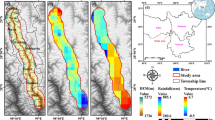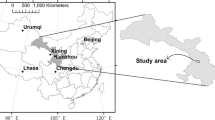Abstract
Differential interferometric synthetic aperture radar (D-InSAR) is an effective technique for geological disaster prevention. In this study, an early landslide detection method based on the D-InSAR technique is proposed. First, SAR data are used to monitor landslide deformation in the Wudongde hydropower reservoir. Then, the ground surface deformation is derived by using the D-InSAR technique, which includes both soil and non-soil deformations. To remove the non-soil deformation, the vertical deformation filter method and slope deformation filter method for extracting soil deformations are established, and the error of D-InSAR results is analyzed. By using two methods, Permanent Scatterers InSAR and Corner Reflectors InSAR, the errors caused by the atmospheric delay are estimated quantitatively. Additionally, the relationship between the landslide deformation and the temporal-spatial change of the SAR data is analyzed, and used to identify landslides. Finally, through the proposed early landslide detection method, the Jinpingzi landslide in the Wudongde area is investigated to validate the proposed method, and the other unknown landslides in this area are also detected, which demonstrates the feasibility of the proposed method. The outcome of this study provides a workable technique for early detection of landslides in valley reservoir areas.












Similar content being viewed by others
References
Achache J, Fruneau B, Delacourt C (1995) Applicability of SAR interferometry for operational monitoring of landslides. In: Proceedings of the Second ERS Applications Workshop, London, pp 165–168
Aulakh NS, Chhabra JK, Kamar A, Aggarwal AK (2004) Development of a fiber optic based system to monitor landslide activity. IETE Tech Rev 21(1):75–81
Berardino P, Costantini M et al (2003) Use of differential SAR interferometry in monitoring and modeling large slope instability at Maratea (Basilicata, Italy). Eng Geol 68:31–51
Brocca L, Galli M, Stelluti M (2005) Preliminary analysis of distributed in situ soil moisture measurements. Adv Geosci 2:81–86
Catani F, Farina P, Moretti S, Nico G, Strozzi T (2005) On the application of SAR interferometry to geomorphological studies: estimation of landform attributes and mass movements. Geomorphology 66(1–4):119–131
Chang ZQ, Gong HL, Zhang JF, Gong LX (2007) A feasible approach for improving accuracy of ground deformation measured by D-InSAR. J China Univ Min Technol 17(2):0262–0266
Colesanti Ferretti A, Prati C, Rocca F (2003) Monitoring landslides and tectonic motions with the Permanent Scatterers Technique. Eng Geol 68(1–2):3–14
Ferretti A, Prati C, Rocca F (2000) Nonlinear subsidence rate estimation using Permanent Scatterers in differential SAR interferometry. IEEE Trans Geosci Remote Sens 38(5):2202–2212
Fruneau B, Achache J, Delacourt C (1996) Observation and modeling of the Saint-etienne-de-Tinee landslide using SAR interferometry. Tectonophysics 265(3–4):181–190
Gabriel AK, Goldstein RM, Zebker HA (1989) Mapping small elevation changes over large areas: differential radar interferometry. J Geophys Res 94(B7):9183–9191
Ge DQ, Wang Y, Guo XF et al (2007) Surface deformation monitoring with coherent point target. J Remote Sens 11(4):574–580 (in Chinese)
Gerardo et al (2011) Analysis with C- and X-band satellite SAR data of the Portalet landslide area. Landslide 8(2):195–206
Goldstein RM, Engelhardt H, Kamb B et al (1993) Satellite radar interferometry for monitoring ice sheet motion: application to an Antarctic ice stream. Science 262(5139):1525–1530
Greif V, Vicko J (2012) Monitoring of post-failure landslide deformation by the PS-InSAR technique at Lubietova in Central Slovakia. Environ Earth Sci 66(6):1585–1595
Herrera G, Notti D, Carlos GJ et al (2011) Analysis with C- and X-band satellite SAR data of the Portalet landslide area. Landslides 8(2):195–206
Hu M, Liu MB, Xie MW, Liu GR (2015) Three-dimensional run-out analysis and prediction of flow-like landslide using smoothed particle hydrodynamics. Environ Earth Sci 73:1629–1640
Huang Y (2009) Research on surface deformation detecting by D-InSAR. Dissertation, PLA Information Engineering University (in Chinese)
Huang J, Xie MW, Wang ZF, Liu XY, Fu Qiang (2012) Research on the DEM precision of canyon acquired by InSAR technique. Remote Sens Appl 1(13):62–67 (in Chinese)
Josep AG, Corominas J, Rius J (2000) Using global positioning system techniques in landslide monitoring. Eng Geol 55(3):167–192
Li DR, Zhou YQ, Ma HC (2000) Principles and applications of interferometry SAR. Sci Surv Mapp 25(1):9–12 (in Chinese)
Li ZH, Liu JN, Xu CJ (2004) Error analysis in InSAR data processing. Geomat Inform Sci Wuhan Univer 29(1):73–76
Li XW, Guo HD, Li Z (2009) DEM generation and accuracy analysis on rugged terrain using ENVISAT/ASAR multi-angle InSAR data. J Remote Sens 02:276–281
Massonnet D, Briole P, Arnaud A (1995) Deflation of Mount Etna monitored by spaceborne radar interferometry. Nature 375(6532):567–570
Meng XJ, Qu CY, Shan XJ et al (2014) Application of PS-InSAR technique to measurement of crustal deformation along the North Fringe Fault Zone of west Qinling Mountains. Seismol Geol 36(1):166–176 (in Chinese)
Pan B (2010) Differential SAR interferometry for deformation monitoring of geological disaster. Dissertation, Wuhan University (in Chinese)
Rizzo V, Tesauro M (2000) SAR interferometry and field data of Randazzo landslide (Eastern Sicily, Italy). Phys Chem Earth 25(9):771–780
Saepuloh A, Minoru U, Aisyah N et al (2013) Interpretation of ground surface changes prior to the 2010 large eruption of Merapi volcano using ALOS/PALSAR, ASTER TIR and gas emission data. J Volcanol Geoth Res 261:130–143
Schlogel R, Doubre C, Malet JP, Masson F (2015) Landslide deformation monitoring with ALOS/PALSAR imagery: a D-InSAR geomorphological interpretation method. Geomorphology 231:314–330
Shan XJ, Ma J, Wang CH et al (2004) Co-seismic ground deformation and source parameters of Mani M7.9 earthquake inferred from spaceborne D-InSAR observation data. Earth Sci 47(6):481–488
Shi BX, Xie GF, Li HZ et al (2014) The major geological research and demonstrate of Wudongde Dam. Yanatze River (20) (in Chinese)
Shu N (2003) Principles of microwave remote sensing. Wuhan University Press, China, pp 110–149
Singhroy V, Couture R, Molch K, Poncos V (2006) InSAR monitoring of post-landslide activity. In Proceedings International Geoscience and Remote Sensing Symposium (IGARSS). Denver, USA, pp 1635–1638
Singhroy V, Alasset PJ, Couture R, Poncos V (2008) InSAR monitoring of landslides on permafrost terrain in Canada. In Proceedings International Geoscience and Remote Sensing Symposium (IGARSS). Boston, USA, p 2451–2454
Squarzoni C, Delacourt C, Allemand P (2003) Nine years of spatial and temporal evolution of the La Valette landslide observed By SAR interferometry. Eng Geol 68(1–2):53–66
Stein A, Zhou Y, Molenaar M (2003) Integrating interferometric SAR data with leveling measurements of land subsidence using geostatistics. Int J Remote Sens 24(18):3547–3563
Strozzi T, Luckman A, Murray T et al (2002) Glacier motion estimation using SAR offset-tracking procedures. IEEE Trans Geosci Remote Sens 40(11):2384–2391
Sun Q, Zhang L, Ding XL et al (2015) Slope deformation prior to Zhouqu, China landslide from InSAR time series analysis. Remote Sens Environ 156:45–57
Tang YM, Zhang MS, Xue Q, Bi JB (2012) Landslide monitoring and early-warning: an overview. Geol Rev 58(3):533–541 (in Chinese)
Tang Z, Li JW, Zhou YQ, Wang BF (2006) Study on aperture shape in curvilinear synthetic aperture radar. Syst Engineering and Electronics 28(8):1115–1119 (in Chinese)
Tian X, Liao MS (2013) The analysis of conditions for InSAR in the field of deformation monitoring. Chin J Geophys 56(3):812–823 (in Chinese)
Tomiyama N, Koike K, Omura M (2004) Detection of topographic changes associated with volcanic activities of Mt. Hossho using D-InSAR. Adv Sp Res 33:279–283
Vietmeier J, Wagner W, Dikau R (1999) Monitoring moderate slope movements (landslides) in the southern French Alps using differential SAR interferometry. In Proceedings 2nd International Workshop on ERS SAR Interferometry. Fringe, Liège, Belgium pp 79–84
Wang ZH (2007) Remote sensing for landslide survey monitoring and evaluation. Remote Sens Land Resour 1:10–15 (in Chinese)
Wang H (2009) Analysis on D-InSAR atmospheric delay errors. Geosp Inform 7(2):9–11 (in Chinese)
Wang YH (2012) Remote Sensing for Landslide. Science Press, Beijing(in Chinese)
Wang ZY, Zhang JZ (2013) Landslides monitoring based on InSAR technique. J Geod Geodyn 33(3):87–91 (in Chinese)
Wang J, Xiang MS, Li SE (2005) A method for extracting the SAR shadow from InSAR coherence. Geomat Inform Sci Wuhan Univer 30(12):1063–1066 (in Chinese)
Wang GJ, Xie MW, Qiu C, Esaki T (2010) Application of D-InSAR technique to landslide monitoring. Rock Soil Mech 31(4):1337–1340 (in Chinese)
Wang GJ, Xie MW, Chai XQ, Wang LW, Dong CX (2013) D-InSAR-based landslide location and monitoring at Wudongde hydropower reservoir in China. Environ Earth Sci 69(8):2763–2777
Wei DT (2012) Simulation of radar backscattering coefficient image at different incidence angle. Remote Sens Inform 27(3):54–59 (in Chinese)
Xia Y, Kaufmann H, Guo XF (2004) Landslide Monitoring in the Three Gorges Area Using D-INSAR and Corner Reflectors. Photogramm Eng Remote Sens 70(10):1167–1172 (in Chinese)
Xing XM (2014) Study on monitoring the time series ground deformation in mining area based on CR-InSAR and PS-InSAR intergration. Acta Geodaetica Cartogr Sin 43(8):878 (in Chinese)
Xu Y, Yue DJ (2013) Quantitative analysis of atmospheric delay error in InSAR and D-InSAR data. Process Site Investig Sci Technol 4:20–23 (in Chinese)
Yan SY, Guo HD, Liu G, Fu WX (2013) Monitoring Muztagh Kuksai glacier surface velocity with L-band SAR data in southwestern Xinjiang, China. Environ Earth Sci 70(7):3175–3184
Yao GQ, Mu JQ (2008) The D-InSAR technique for the land subsidence monitoring. Earth Sci Front 15(4):239–243
Yang CS, Zhang Q, Zhang JQ (2015) Reliability analysis of the atmospheric delay phase separated by InSAR time series method. J Geod Geodyn 35(1):92–96
Yin YP, Zheng WM, Liu YP, Zhang JL, Li XC (2010) Integration of GPS with InSAR to monitoring of the Jiaju landslide in Sichuan, China. Landslide 7:359–365
Zebker HA, Rosen PA, Goldstein RM et al (1994) On the derivation of coseismic displacement fields using differential radar interferometry: the Lander earthquakes. Geophys Res 99B(10):19617–19634
Zhang J, Hu GD, Luo NB (2004) Landslide monitoring by InSAR. Chinese J Eng Geophys 1(2):147–153 (in Chinese)
Zhang YZ, You YS, Lan JS (2010) Error analysis of baseline, phase and atmosphere delay in InSAR data processing. Remote Sens Technol Appl 25(3):399–403 (in Chinese)
Zhang JX, Wei JJ, Zhao Z, Huang GM (2011) Color orthophoto map generation based on Multi-direction and Multi-polarization SAR data fusion. Acta Geodaetica Cartogr Sin 40(3):276–282
Zhou X, Bao Z (2008) Research on SAR target characteristics analysis. Comput Eng Sci 30(7):40–46
Acknowledgments
This project was supported by the Changjiang Institute of Survey, Planning, Design, and Research, the National Natural Science Foundation of China (No. 41372370).
Author information
Authors and Affiliations
Corresponding author
Electronic supplementary material
Below is the link to the electronic supplementary material.
Rights and permissions
About this article
Cite this article
Xie, M., Huang, J., Wang, L. et al. Early landslide detection based on D-InSAR technique at the Wudongde hydropower reservoir. Environ Earth Sci 75, 717 (2016). https://doi.org/10.1007/s12665-016-5446-3
Received:
Accepted:
Published:
DOI: https://doi.org/10.1007/s12665-016-5446-3




